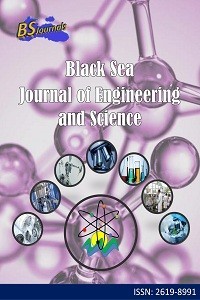Risk Analysis and Evaluation of the Current Situation in Terms of Work Safety in The Drinking Water Treatment Plant
Water treatment plants, Clean water, Drinking water treatment plant, Hazard, Risk analysis
Risk Analysis and Evaluation of the Current Situation in Terms of Work Safety in The Drinking Water Treatment Plant
Water treatment plants, Clean water, Drinking water treatment plant, Hazard, Risk analysis,
___
- Al-Otoum F, Al-Ghouti MA, Ahmed TA, AbuDieyeh M, Ali M. 2016. Disinfection by-products of chlorine dioxide (chlorite, chlorate, and trihalomethanes): Occurrence in drinking water in Qatar. Chemosphere, 164: 649-656.
- Anonymous. 2009. Occupational Hazard Datasheets- Water treatment Plant Operator-ILO. http://www.ilo.org>publication>wcms_190172 (access date: October 13, 2021).
- Anonymous. 2016. Occupational Safety ande Health risk assessment Methodologies, https://oshwiki.eu/wiki/Occupational_safety_and_health_risk_assessment_methodologies (access date: October 21, 2021).
- Çakmakçı M, Özkaya B, Yetilmezsoy K, Demir S. 2013. Su arıtma tesislerinin işletme esasları. C. Orman ve Su İşleri Bakanlığı Su Yönetimi Genel Müdürlüğü 55-79, İstanbul, Türkiye, pp: 446-452.
- Demircioğlu M, Centel T. 2007. İş Hukuku, 12. Baskı, Beta Basım Yayım Dağıtım, İstanbul, Türkiye, pp: 208.
- Ertaş S, Sarımehmetoğlu B. 2019. Su güvenliği. Erciyes Üniv Vet Fak Derg, 16(2): 141-146.
- Karagüzel O, Akkaya H, Tezgel İ. 2003. Trabzon Belediyesi İçme suyu arıtma tesisleri, Celepler matbaacılık, Trabzon, Türkiye, pp: 55.
- Ministry of Labor and Social Security, Occupational Health and Safety Risk Assessment Regulation, Official Gazette Issue: 28512, Official Gazette date: 29/12/2012.
- Occupational Health and Safety Law. 2013. URL: http://www.mevzuat.gov.tr (access date: October 02, 2021).
- Özgür C. 2021. Risk analysis in disinfection unit: drinking water treatment plant. NOHU J Eng Sci, 10(1): 16-22.
- Özkılıç Ö. 2005. İş Sağlığı ve Güvenliği, Yönetim Sistemleri ve Risk Değerlendirme Metodolojileri. TİSK Yayınları, Ankara, Türkiye, pp: 219.
- Özkılıç Ö. 2007. İş Sağlığı, Güvenliği ve Çevresel Etki Risk Değerlendirmesi, Tisk Yayınları, Ankara, Türkiye, pp: 540.
- Spellman FR. 2003. Handbook of water and wastewater treatment plant operations. Lewis Pub., New York, US.
- Srinivasan PT, Viraraghavan T, Subramanian KS. 1999. Aluminium in drinking water: An overview. Water SA, 25(1): 47-56.
- Tekbaş H. 2013. To assess the risks of an industrial plant using the method of matrix under the occupational healty and safety regulations and analyze the results. MSc Thesis, Trakya University, Institute of Science, Department of Mechanical Engineering, Edirne, Türkiye, pp: 98.
- Uzun S. 2011, Use of ozone for improving of water quality and its chemical effects. Türk Hijyen Denl Biyol Derg, 68(2): 105-113.
- Vasović D, Stanković S, Vranjanac Ž. 2018. Working conditions at the water treatment plants: activities, hazards and protective measures, safety engineering. Inženjerstvo Zaštıte, 8(1): 27-32.
- WHO. 2003. Aluminium in Drinking-water. Background document for development of WHO Guidelines for Drinking-water Quality WHO/SDE/WSH/03.04/53.
- Yayın Aralığı: 6
- Başlangıç: 2018
- Yayıncı: Uğur ŞEN
Ağır Araç Fren Diskinin Sonlu Elemanlar ile Termo-Mekanik Analizi
Recep Kadir SİVRİ, İbrahim KELES
Volkan Murat YILMAZ, Kenan YILDIZ
Hülya ÖZKOÇ, Cemre Gizem SAĞLAM, Ayşenur USLU
The Design and Construction of a Locally Sourced Electric Powered Stair Climbing Trolley
Dıckson Davıd OLODU, Marvellous ABRAHAM, Jackson JESUOROBO, Odezi Oghenerukevwe AKIAKEME
Comparison of Different Tools and Methods in the Measurement of Leaf Area in Alfalfa
Bağırkaçdere (Çanakkale) Pb-Zn Yatağı’nın 3B Cevher Blok Modellemesi
